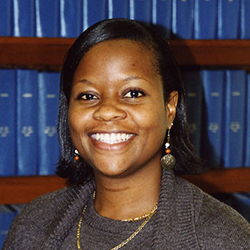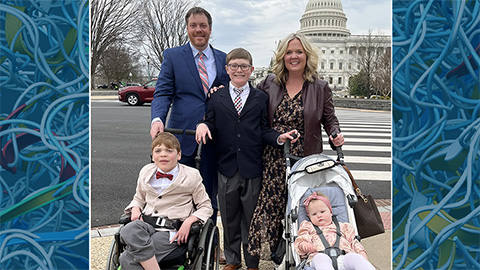Where do we go from here?
A diverse workforce is critical to ensuring that the U.S. remains at the forefront of the disciplines of science, technology, engineering and math. Diversity enhances the breadth, depth and quality of research and increases innovation by engaging people with a variety of experiences and perspectives. It is projected that by 2050 the demographics of the U.S. will have shifted profoundly, and Hispanics and Latinos will represent nearly one third of the population.
These statistics point to the critical importance of a multipronged approach that insures the STEM workforce diversifies. While undergraduate research training programs such as Minority Access to Research Careers have evolved significantly since I was a MARC fellow over two decades ago, there is room for developing additional strategies in STEM-centered training programs so that the next generation of scientists reflects the demographic makeup of the country. Equally important are the development and expansion of targeted strategies to capture minority scientists that are lost at key junctures along the training pipeline.
Here are potential strategies that may help to broaden inclusion of underrepresented minorities, or URM, in STEM:
.jpg)
Foster diverse skills
Undergraduate research programs attempting to broaden URM participation have emphasized the development of technical skills, with the hope that these experiences would spawn an interest in STEM-related research careers. But summer and year-long research programs that foster the development of a more diverse cadre of skills also are warranted. These programs should stress bioscience career skills that are vital for success, such as communication, critical thinking, problem solving and collaboration. Perhaps most importantly, undergraduate research programs should develop activities that boost confidence and a sense of belonging and address the psychosocial issues associated with trying to assimilate into an institutional climate that is vastly different from one’s life experiences.
Attach federal requirements
Federally funded training programs should require that participating institutions and laboratories train all workers in the areas of cultural competency, implicit bias and stereotype threat. Providing PIs, postdocs, graduate students and staff with inclusion tools may help mitigate the feelings of isolation in trainees that can undermine their commitment to bioscience careers. Equally important are opportunities for trainees to develop a sense of community. To this end, federal agencies should require that training grant recipients develop opportunities for trainees to interact with other students, postdocs and faculty in informal, nonthreatening settings. These resources also should be adopted in the institutions’ classroom settings.
Expand promising programs
Efforts should be made to expand programs that have a demonstrated track record of increasing the diversity of the professoriate. For example, the Institutional Research and Academic Career Development Award program is an initiative of the National Institute of General Medical Sciences that helps postdoctoral scientists to meld research training with pedagogical studies and teaching skills. The program has established partnerships between research-intensive institutions and minority-serving schools and supported a diverse cohort of trainees, more than 50 percent of whom are women and minorities. A large proportion of awardees have matriculated into faculty positions in varied settings including research-intensive institutions, community colleges, primary undergraduate institutions and minority-serving institutions. The endeavor’s outcome data provide a compelling rationale to expand from the 20 institutions currently funded and for other National Institutes of Health divisions to adopt the initiative.
Address grant disparities
Donna K. Ginther and colleagues published a paper in Science in 2011 that raised awareness of the disparity between white and underrepresented minority PIs receiving NIH funding. According to Ginther, African Americans were 10 percent less likely to be awarded a grant. While unconscious bias or a need for mentoring in grantsmanship may contribute to these findings, what is clear is that there is an urgent need for tangible initiatives to address this disparity. With the recommendation of its Working Group on the Diversity of the Biomedical Research Workforce, the NIH is in the initial phases of implementing new strategies to address the issue. But if we want to promote real change, substantive action has to come not only from the NIH but from all members of the STEM workforce, including grant reviewers, other funding agencies and institutions of higher education. For starters, ensuring that grant review panels include underrepresented minorities is likely to contribute to more equity in the review process.
Diversify the professoriate
We need to mandate that university search committees interview collections of candidates that more closely mirror the general population. Increasing the diversity of the professoriate provides successful role models for students and trainees. Having as role models successful mentors with similar backgrounds increases confidence and retention and fosters a supportive environment. While many universities have implemented these practices and increased the percentage of female faculty, search committees should be vetted carefully to generate not only a diverse applicant pool but also a diverse cadre of committee representatives. One additional model would involve programs specifically designed to enhance the number of faculty from underrepresented groups at the rank of full professor and other positions in the upper echelons of academic and government leadership. At this point, the numbers of minorities in leadership positions with training in biochemistry and molecular biology remains low.
Offer career training
Underrepresented minorities disproportionately elect to pursue nonacademic, research-related careers. Offering URMs substantive career training activities and exposure at an earlier stage is likely to create easier transitions during graduate and postgraduate training. Developing federally funded training programs equivalent to IRACDA for trainees interested in science policy, science communication and outreach, and patent law would help to retain trainees and increase the value of the doctoral degree in a STEM discipline. This also would help to dispel the disparaging connotation of “alternative careers” and help to maximize the impact of STEM training in research-related fields.
Assess outcomes
The outcomes of federally funded programs aimed at broadening URM participation need to be assessed rigorously. In-depth analyses that identify best practices for engagement and retention of URMs at all phases of the pipeline would provide key data that could be used to maximize future resource allocations.
Establish networks
It is also important to establish networks of underrepresented minority trainees and faculty that extend beyond the borders of an institution or society. This type of network could be a forum for undergraduate, graduate, postdoctoral and faculty underrepresented scientists and could reduce significantly feelings of isolation. Efforts such as the National Research Mentoring Network are beginning to address this issue by providing a virtual online resource. However, this also could be facilitated through regional networks where underrepresented minority undergraduate and graduate students interact with postdocs and faculty that are navigating diverse biological and biomedical career paths. This type of forum could help to instill self-affirming practices in trainees and enable them to model their success in a supportive network. These networks also would facilitate the exchange of best practices and strategies among programs and build stronger connections between training programs and trainees, particularly with regional minority-serving institutions.
Marion B. Sewer, 1972 – 2016

Shortly before this issue went to press, we learned that the author of this article, Marion B. Sewer, passed away unexpectedly. Sewer, who was just 43 years old at the time of her death, was a professor at the Skaggs School of Pharmacy and Pharmaceutical Sciences at the University of California, San Diego, where she sought to define the mechanisms that control steroid hormone biosynthesis. She also was the deputy chair of the ASBMB Minority Affairs Committee, a co-organizer of the forthcoming annual meeting symposium on nonalcoholic fatty liver disease and a frequent contributor to this magazine. Her passing is a great loss to the ASBMB community.
– The editors
Enjoy reading ASBMB Today?
Become a member to receive the print edition four times a year and the digital edition monthly.
Learn moreGet the latest from ASBMB Today
Enter your email address, and we’ll send you a weekly email with recent articles, interviews and more.
Latest in Opinions
Opinions highlights or most popular articles

Debugging my code and teaching with ChatGPT
AI tools like ChatGPT have changed the way an assistant professor teaches and does research. But, he asserts that real growth still comes from struggle, and educators must help students use AI wisely — as scaffolds, not shortcuts.

AI in the lab: The power of smarter questions
An assistant professor discusses AI's evolution from a buzzword to a trusted research partner. It helps streamline reviews, troubleshoot code, save time and spark ideas, but its success relies on combining AI with expertise and critical thinking.

How AlphaFold transformed my classroom into a research lab
A high school science teacher reflects on how AI-integrated technologies help her students ponder realistic research questions with hands-on learning.

Writing with AI turns chaos into clarity
Associate professor shares how generative AI, used as a creative whiteboard, helps scientists refine ideas, structure complexity and sharpen clarity — transforming the messy process of discovery into compelling science writing.

Teaching AI to listen
A computational medicine graduate student reflects on building natural language processing tools that extract meaning from messy clinical notes — transforming how we identify genetic risk while redefining what it means to listen in science.

What’s in a diagnosis?
When Jessica Foglio’s son Ben was first diagnosed with cerebral palsy, the label didn’t feel right. Whole exome sequencing revealed a rare disorder called Salla disease. Now Jessica is building community and driving research for answers.

